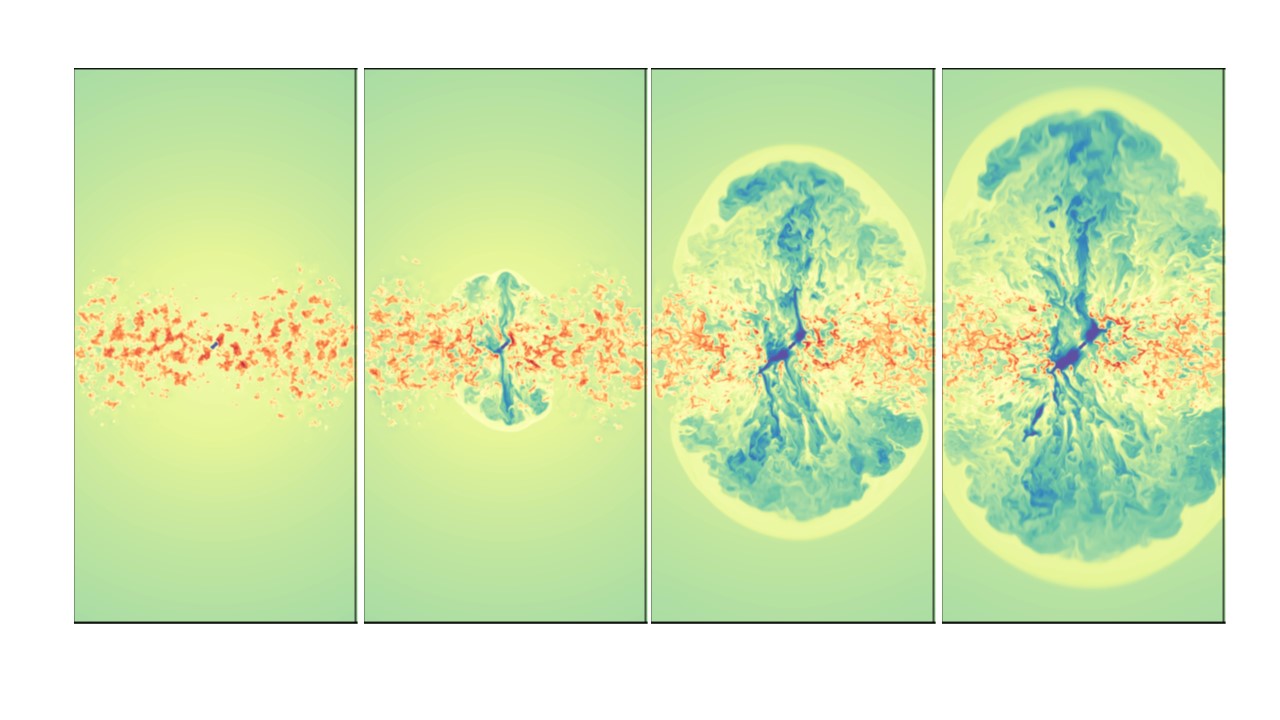
An international team of astronomers led by JIVE postdoc has discovered that even a weak jet stream from a low-active black hole can be a kind of leaf blower to clean parts of a galaxy. The observed black hole removes about 75% of the cold gas in the central regions of the galaxy in a few million years. This probably stops the formation of stars. The researchers published their findings on Thursday 10 February 2022 in the journal Nature Astronomy.
Until now, astronomers have always assumed that only black holes with strong radiation stop star formation from within the galaxy. This is because these black holes blow away gas, which is the building block for stars. The question, however, is whether galaxies without strongly radiating black holes are also inhibited in their growth.
Radio emitter
Now, astronomers have discovered a less powerful black hole that also seems to be cleaning up its surroundings. This low-power black hole is found in the galaxy B2 0258+35 in the constellation of Perseus. It does not emit strong radiation but has radio plasma jets that are bright, as opposed to black holes that emit visible light, ultraviolet or X-rays.
The gas at B2 0258+35 is blown away steadily at a speed of about 500 kilometres per second. It is roughly five to ten solar masses per year and takes a few million years. The gas is not moving fast enough to escape from the reach of the galaxy. It eventually falls back and ends up at the edges of the galaxy. From there, it cannot properly form new stars.
Growth inhibitor
"That low-power radio jets have also been found to clean a galaxy is extraordinary," says principal investigator and JIVE postdoc Suma Murthy. "A large part of the radio emitters are relatively quiet. It was thought that they did not play an important role in growth inhibition. Our results show that these relatively weak radio-emitters can indeed inhibit growth. From now on, we will have to take this into account in models for the evolution of galaxies."
The astronomers made their observations in October and November 2020 with the Northern Extended Millimetre Array (NOEMA) telescopes. It is a collection of radio dishes in the French Alps at an altitude of about 2,500 metres. The observations had previously been predicted by computer simulations.
Murthy defended her PhD thesis at the University of Groningen on 8 February 2022. She worked at ASTRON and at the Kapteyn Institute of the University of Groningen during the research and now works as a postdoc at JIVE.
Background information
The Joint Institute for VLBI ERIC (JIVE) has as its primary mission to operate and develop the European VLBI Network (EVN) data processor, a powerful supercomputer that combines the signals from radio telescopes located across the planet. Founded in 1993, JIVE is since 2015 a European Research Infrastructure Consortium (ERIC) with seven member countries: France, Italy, Latvia, the Netherlands, United Kingdom, Spain and Sweden; additional support is received from partner institutes in China, Germany and South Africa. JIVE is hosted by the Netherlands Institute for Radio Astronomy (ASTRON) in the Netherlands.
The Netherlands Research School for Astronomy (NOVA) is the alliance of the astronomical institutes of the universities of Amsterdam, Groningen, Leiden, and Nijmegen. The mission of Top Research School NOVA is to carry out frontline astronomical research in the Netherlands, to train young astronomers at the highest international level, and to share its new discoveries with society. The NOVA laboratories are specialised in building state-of-the-art optical/infrared and submillimeter instrumentation for the largest telescopes on earth.
Publication
Cold gas removal from the centre of a galaxy by a low-luminosity jet. By: Suma Murthy (1,2,3), Raffaella Morganti (2,1) Alexander Y. Wagner (4), Tom Oosterloo (2,1) Pierre Guillard (5,6), Dipanjan Mukherjee (7) & Geoffrey Bicknell (8). In Nature Astronomy, 10 February 2022. Original: https://www.nature.com/articles/s41550-021-01596-6. Preprint: https://www.astronomie.nl/upload/files/2022/Murthy_et_al_2022.pdf.
1. Kapteyn Astronomical Institute, University of Groningen, the Netherlands
2. ASTRON, Netherlands Institute for Radio Astronomy, Dwingeloo, the Netherlands
3. Joint Institute for VLBI ERIC, Dwingeloo, the Netherlands
4. Center for Computational Sciences, University of Tsukuba, Ibariki, Japan
5. Institut d’Astrophysique de Paris, Sorbonne Université, CNRS, Paris, France
6. Institut Universitaire de France, Ministère de l’Enseignement Supérieur et de la Recherche, Paris, France
7. Inter-University Centre for Astronomy and Astrophysics, Pune, India
8. Australian National University, Research School of Astronomy and Astrophysics, Weston, Australia
Image
Four-step simulation of a black hole with a low energy radio jet that clears the centre of a galaxy like a leaf blower. There are 200,000 years between each image. Credit: Mukherjee et al.
Download image in high resolution
Download animated gif
Contact
Suma Murthy
Joint Institute for VLBI ERIC (JIVE)
ASTRON, Netherlands Institute for Radio Astronomy
Kapteyn Astronomical Institute, University of Groningen
murthy@jive.eu
Raffaella Morganti
ASTRON, Netherlands Institute for Radio Astronomy
Kapteyn Astronomical Institute, University of Groningen
morganti@astron.nl
Jorge Rivero González
JIVE Science Communications Officer
Joint Institute for VLBI ERIC (JIVE)
rivero@jive.eu
